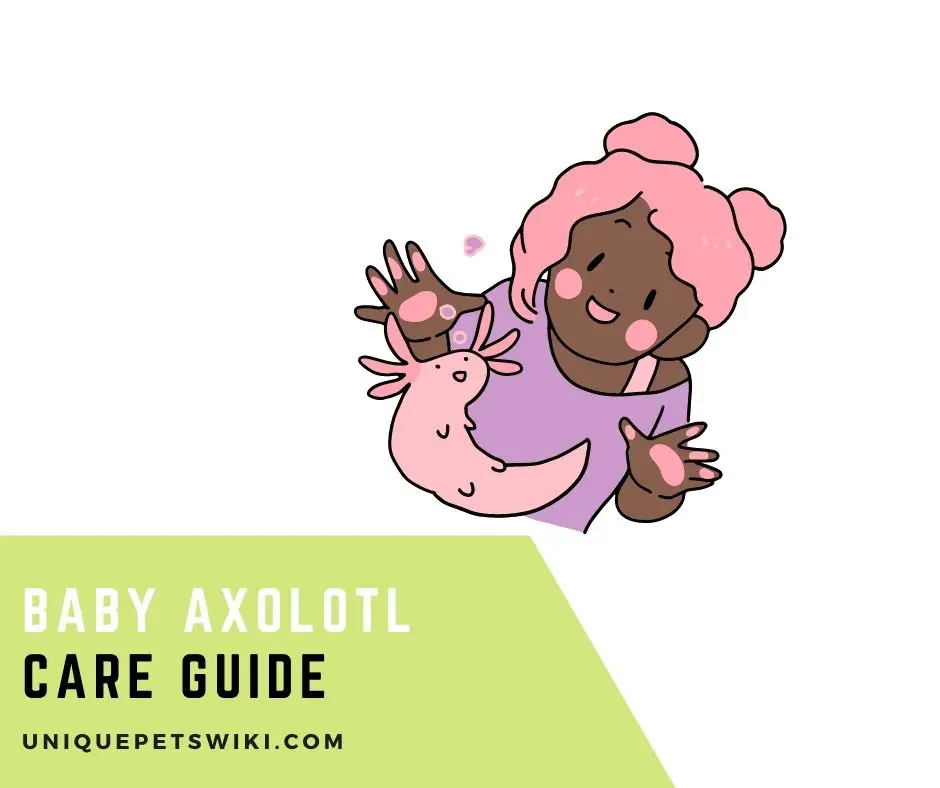Axolotls are unique salamander species that are popularly kept as a pet. However, axolotls require specific care, making it hard for beginners to keep them.
As a result, it is important that you research baby axolotl care before you decide to raise one or more baby axolotls.
It can be quite tricky to care for baby axolotls if you don’t have prior experience in fish breeding. It usually takes 15-20 days for axolotl eggs to hatch.
After hatching, they have a fast growth rate, and it is important that you separate them from their parents to help prevent cannibalism.
This guide will highlight everything that you need to know about caring for baby axolotls, from setting up their tank to the common health problems that can affect them.
This article has been reviewed by Dr. Gospel. Read more about our knowledge control process here.
Contents
What do Do Baby Axolotls Need?
Baby axolotls require special care as they are very sensitive to water quality, temperature fluctuations, and the oxygen level in the tank.
Therefore, you should provide an ideal tank requirement for them and be on the lookout for the water conditions to keep them healthy and active.
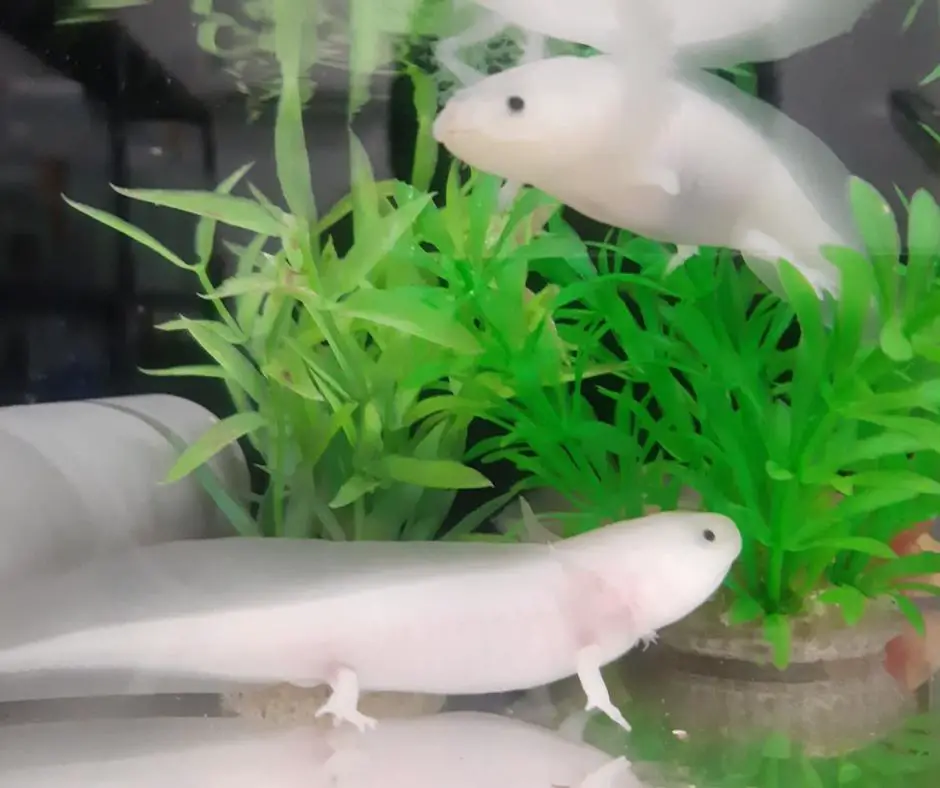
How to Set Up A Baby Axolotl Tank?
Although axolotls are small at birth, usually around half an inch, they usually grow rapidly and can grow to an inch in just two weeks if provided with the right diet and environment.
Most pet owners keep baby axolotl in small glass jars or plastic containers for the first three weeks as they need more aeration.
Furthermore, baby axolotls produce lots of waste, and it is important that you change their water frequently.
Some of the other things that you need to set up in a baby axolotl tank are stated below:
Tank Size and Axolotl
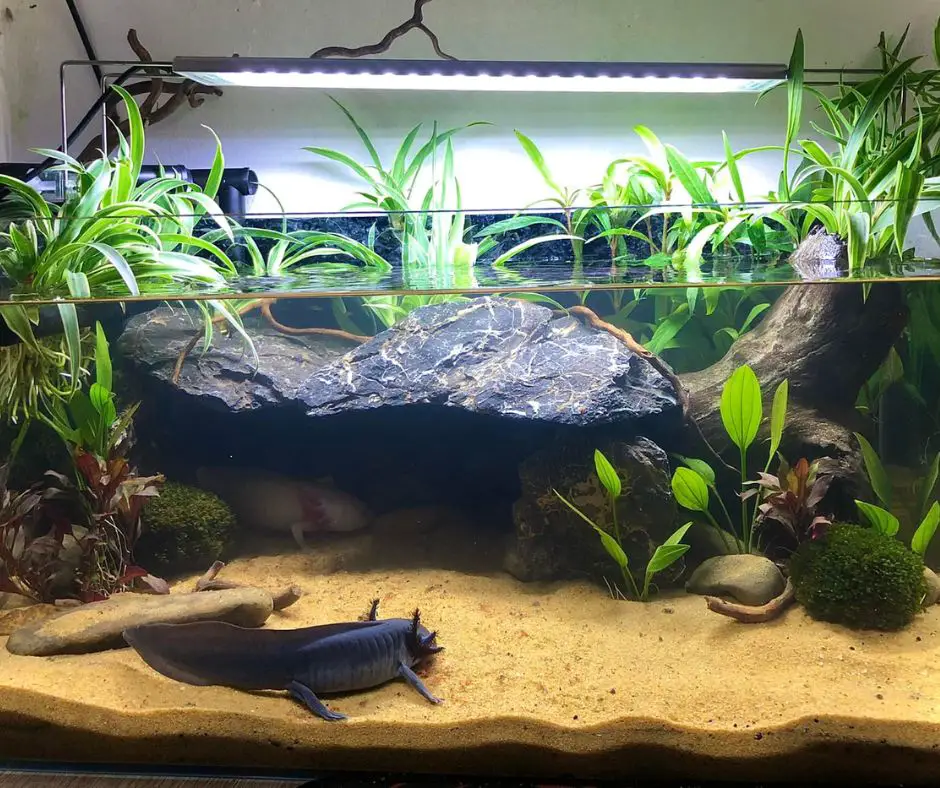
The first thing to decide when housing a baby axolotl is the size of their tank. The minimum tank size to house a baby axolotl is 20 gallons.
This is because baby axolotls produce lots of waste, and housing them in a larger tank can help keep the water parameter in their tank stable.
Furthermore, you can house up to 200 newly hatched axolotls in a 20-gallon tank, but it is not advisable to do that.
It is recommended to house about 100 axolotl hatchlings together in a tank to help reduce unnecessary death and loss of legs.
After your axolotls develop their front legs, you can divide them into smaller colonies. After developing into the juvenile stage, you can keep one or two axolotls together if they are the same size.
You can keep them in a 10–20-gallon tank, but a larger tank size is recommended to help ensure they avoid each other.
Lighting Requirements
Generally, axolotls don’t require special lighting because they have poor vision. They are also sensitive to light as they don’t have eyelids.
Therefore, putting a light in your baby axolotl’s enclosure is not necessary.
However, you can use dim lighting if you plan to provide lighting for your baby axolotl. You will need to create a dark place where they can hide if you want to provide lighting.
Lid
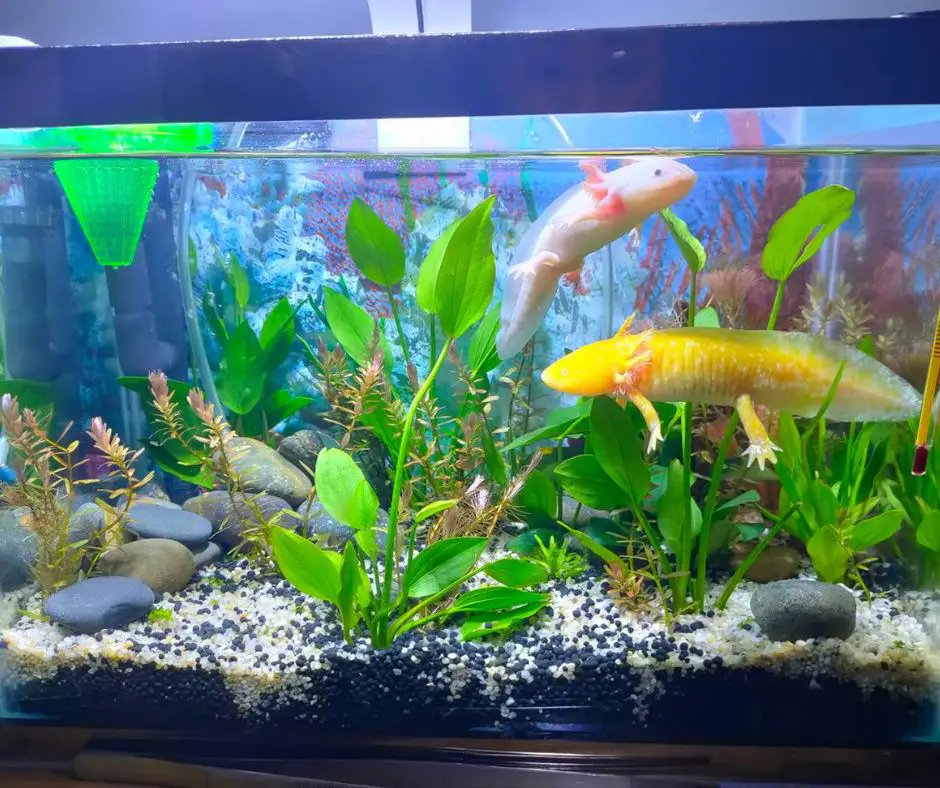
Although axolotls are bottom dwellers and don’t leave the water, you can find them jumping from their tank.
You will need a lid to help prevent your baby axolotl from jumping out of their tank. Furthermore, the lid will help keep foreign bodies out of your axolotl’s tank.
Also read: Can Axolotl Live Out of Water?
Substrate
Many axolotl owners believe substrates help make axolotls feel more secure, while some think substrates are unnecessary in an axolotl’s tank.
However, putting substrates in your axolotl’s enclosure helps to provide something to grip comfortably while roaming through their tank.
The ideal substrate for baby axolotl is sand. Sand will help to provide grip on the tank’s bottom and enrich the tank.
Furthermore, sand has very small particles and cannot cause impaction if your axolotl mistakenly swallows it.
You can also decide not to use a baby axolotl’s tank substrate. This will help to make cleaning their tank much easier as you just suck up the solid waste during the water change.
However, you should avoid any kind of gravel as it can cause injury and impaction if your axolotl mistakenly swallowed it.
Also read: 2 Best Aquarium Sand for Axolotl
Hides
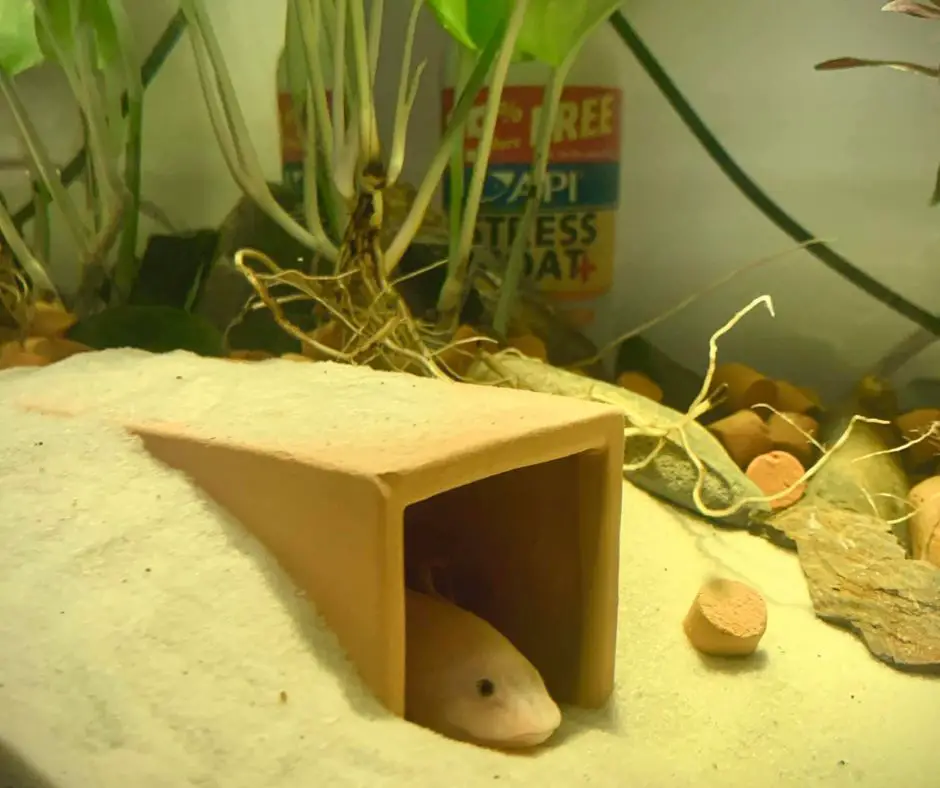
It is important that you provide baby axolotls with places to hide, especially in a tank with lighting. This is because baby axolotls have sensitive eyelids and will need a dark corner to hide when the light is on.
Hides help to give axolotls a sense of security and can enhance the appearance of their tank. You can create a hide for baby axolotls by adding ceramic pies, caves, or other structures into their tank.
Plants
You can also add plants to your baby axolotl tanks. Plants can serve as a cover from light and as an enrichment.
However, using the plant for the axolotl tank is unnecessary because axolotls love digging and can dig out any plants placed in their tank.
As a beginner, it is not recommended to use live plants for their tank. This is because live plants need light which your axolotls are sensitive to.
However, experts can use low-light live plants that like cold water to set up their tank.
You can also use floating plants or plants that grow on other ornaments. Another great alternative is driftwood.
Driftwood provides a great place for the axolotl to hide and explore. Furthermore, some types of plants can grow on driftwoods.
Beginner axolotl owners can use artificial plants for their axolotl’s enclosure as they don’t require light.
Water Quality and Temperature
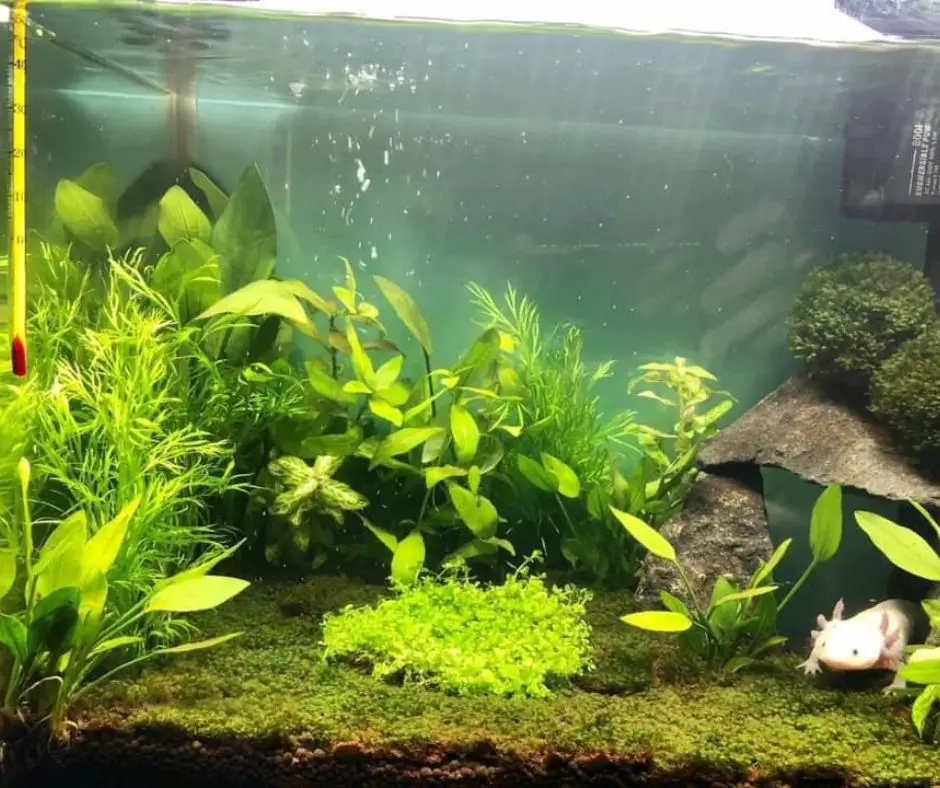
Axolotls are sensitive to water quality, baby axolotls are even more sensitive to water quality.
Therefore, it is important that you keep an eye on the water quality when it comes to tank maintenance. You will need to regularly change the water in baby axolotl tanks to help keep it clean.
Failure to do this can cause poor water quality, leading to death. Furthermore, the water you are changing should be treated before putting it in your baby axolotl’s tank.
This is because some water, like tap water, contains chemicals like chlorine and heavy metals that can be fatal if used untreated.
Here are some water parameters that you need to monitor to keep your baby axolotl healthy:
- pH: the ideal pH for baby axolotls is between 7.4-and 7.6. However, they can survive in water with a pH of around 6.5-8.0.
- Ammonia: should be 0 ppm.
- Nitrite: should be 0 ppm
- Nitrate: should be less than 40 ppm
Baby axolotls usually require the same temperature range as adult axolotls. However, you will need to put your baby axolotl in slightly warmer water for optimal growth.
An ideal temperature for axolotls hatching eggs and newly hatched fries is 72oF or 22oC.
You can then lower the temperature to around 60-64oF or 16-18oC slowly. This will help your baby axolotl to adapt to the new temperature without going into shock.
You will need an accurate thermometer in your baby axolotl’s tank to help monitor the temperature change in their water.
Since you will be keeping your axolotls at room temperature, you will need to cool their tank to help get the ideal temperature.
Also read: How To Keep An Axolotl Tank Cold
Supplies
Here are some supplies that your baby axolotls require:
Filter
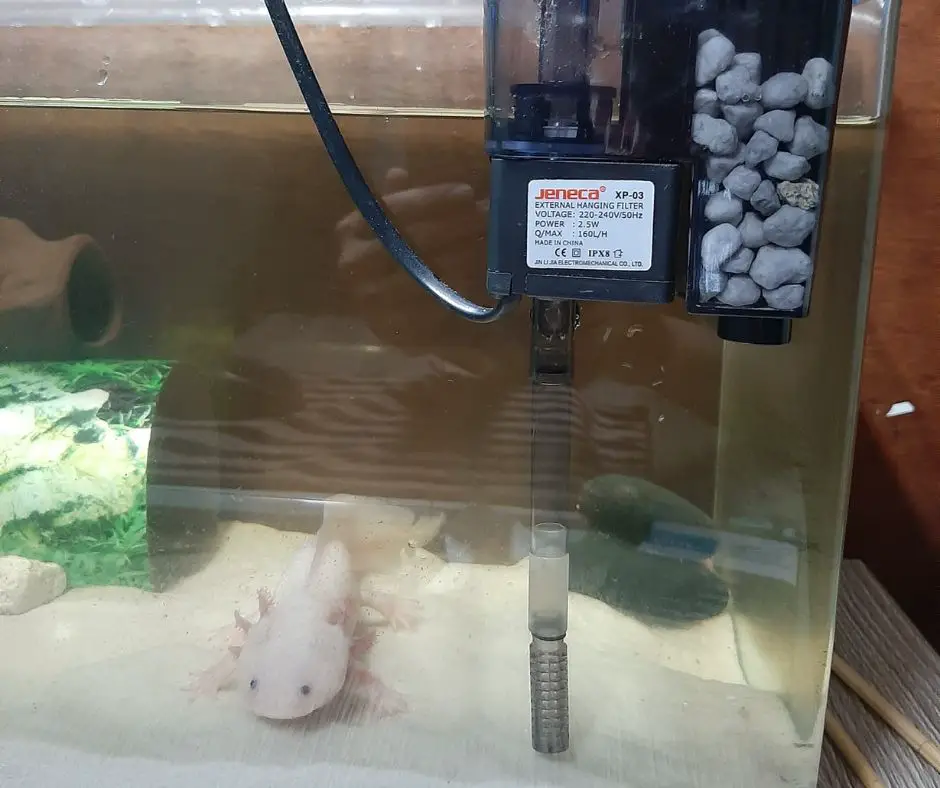
One of the supplies you will need in your baby axolotl’s enclosure is a filter. It is important to filter baby axolotl’s tank to ensure the water in their tank is always in good condition for them to grow properly.
Baby axolotls require slow-moving water and you should consider this when choosing a filter for their tank.
Therefore, you will need to avoid a filter that generates strong-moving water. Furthermore, they are messy creatures, and you will need a filter that can circulate large water in a short time.
An ideal filter for baby axolotl is the sponge filter. Sponge filters help circulate water quickly without creating lots of water flow.
You can also buy biofoam filters as they can clean your axolotl’s water and allow the growth of beneficial bacteria in the filter media.
The bacteria will then help keep the tank’s water parameter stable.
However, you will need to change your axolotl water regularly if there are no filters in their tank. You will be required to change their water daily to ensure good water quality.
On the other hand, you can replace water less frequently if your baby axolotls are equipped with a filter.
When doing a water change, it is best to remove 20% of the water from the tank and then replace it with water treated with a water conditioner.
Note: You should siphon the water at the tank’s bottom when removing water. You should also make sure that the water you are using for replacement is at the same temperature as the tank’s water.
Also read: 7 Best Water Filter For Axolotl
Freshwater Master Test Kit
It is important that you have a good water test kit as a responsible axolotl owner.
A good water test kit helps to ensure you can track the water quality parameters such as the pH, ammonia, nitrates, and nitrites level in your baby axolotl tank.
You can opt for an API freshwater master test kit for this job.
API Water Test Kit
- Contains one (1) API FRESHWATER MASTER TEST KIT 800-Test Freshwater Aquarium Water Master Test Kit, including 7 bottles of testing solutions, 1 color card and 4 glass tubes with cap
- Helps monitor water quality and prevent invisible water problems that can be harmful to fish and cause fish loss
- Accurately monitors 5 most vital water parameters levels in freshwater aquariums: pH, high range pH, ammonia, nitrite, nitrate
- Designed for use in freshwater aquariums only
- Use for weekly monitoring and when water or fish problems appear
Last update on 2022-12-30 / Affiliate links / Images from Amazon Product Advertising API
Cycling
Cycling an axolotl tank is usually the last step before introducing an axolotl to its new home.
Tank cycling is the process of leaving the tank for two weeks to help the water conditions settle and allow the growth of algae and bacteria in the tank.
Cycling a tank is very important to your baby axolotl’s health. This is because baby axolotls produce lots of waste, leading to a build-up of ammonia, and can be fatal.
However, the cycling of a tank can help convert the ammonia to nitrate at a safe level.
Furthermore, cycling can help ensure that your baby axolotl gets natural food like phytoplankton and zooplankton in their tank.
Also read: How To Cycle Tank For Axolotl: 7 Steps for Beginners
Location
As stated before, baby axolotls are very sensitive to bright light. Furthermore, exposing your baby axolotl’s tank to direct sunlight can raise their water temperature, causing stress to your axolotl.
Therefore, it is recommended that you keep their tank away from direct sunlight.
Also read: 3 Best Axolotl Aquarium Setup Ideas
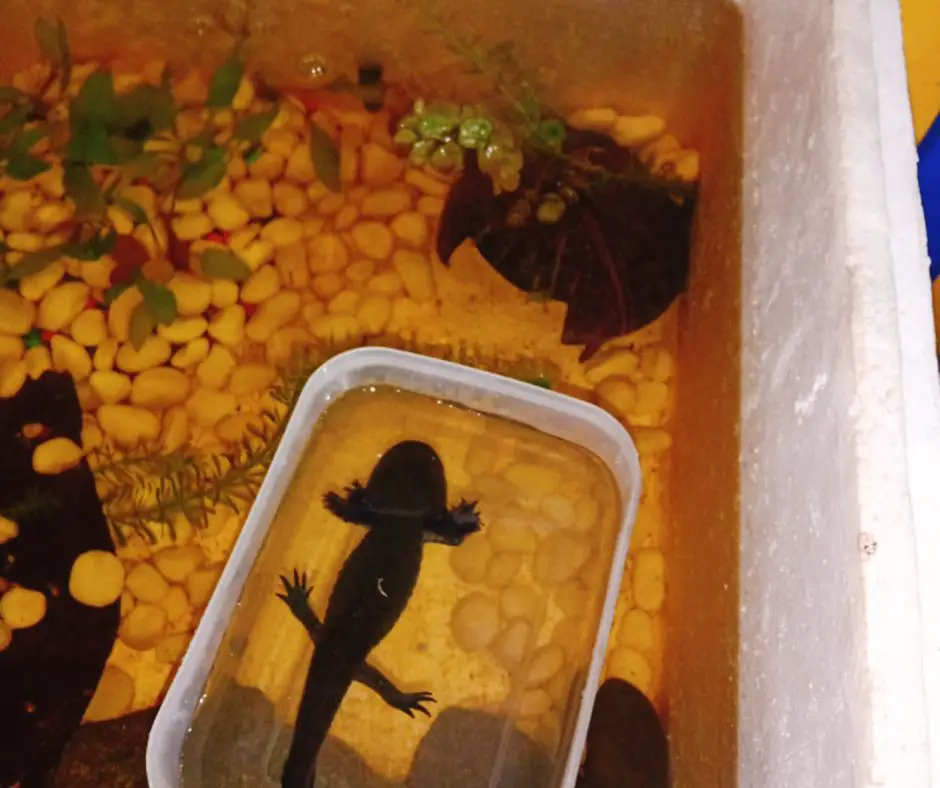
What Does a Baby Axolotl Eat?
Like adult axolotls, baby axolotls are carnivorous creatures and require a meat-based diet.
However, baby axolotls rely on movement to help detect their food sources, and it is recommended that you feed them with live foods.
Some of the things you need to know about baby axolotl food choices are stated below.
Newly Hatched Axolotls
A newly hatched axolotl usually doesn’t move or eat 24-72 hours after hatching. During this period, they will absorb their egg yolk rich in protein.
After this, you can start to feed your baby axolotls with only live food as they can only see foods that move in their front.
Some of the live food you can use to feed them are micro worms, daphnia, baby brine shrimp, white worms, mosquito larvae, and underwater bugs.
You need to ensure that the food source is little, as axolotl hatchlings have tiny mouth openings.
You can use a turkey baster to place the food directly in front of your baby axolotls. Furthermore, you should ensure that you remove all leftover foods from their tank after feeding time.
Note: axolotl hatchlings usually ignore foods that are not alive.
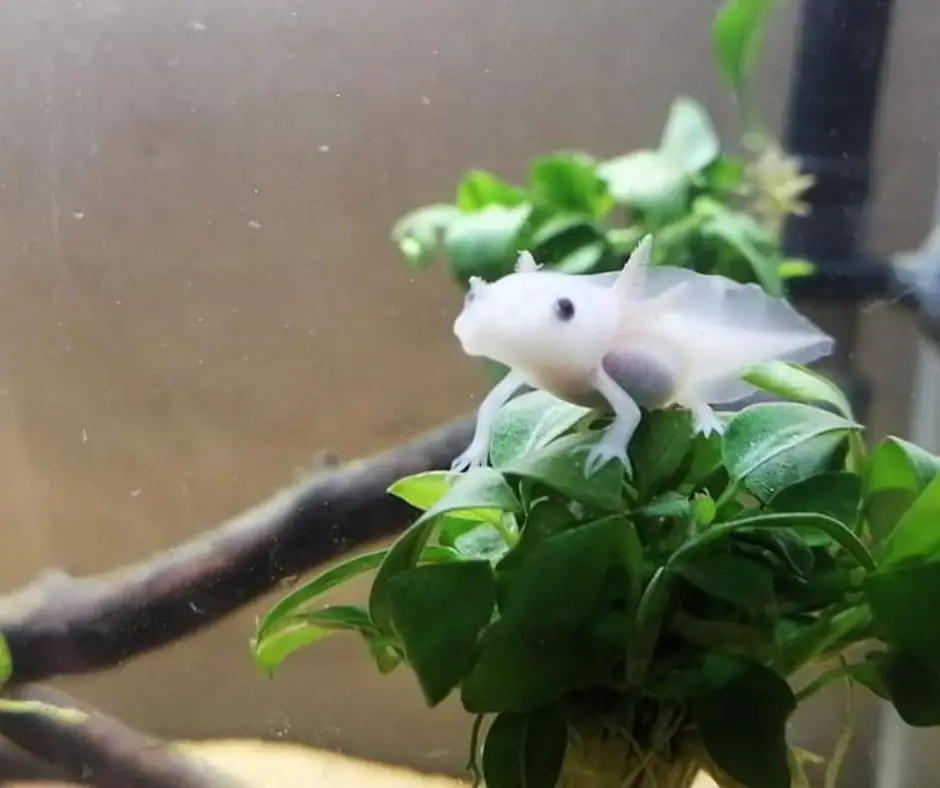
Baby Axolotl
Baby axolotls will become more mobile and actively hunt for their food after developing their front legs.
You can even introduce some dead feeder items to your axolotls during this period. Some of the food options to feed baby axolotl are:
- Live brine shrimp
- Frozen brine shrimp
- Frozen bloodworms
- Live mosquito larvae
- Earthworms
- Live bloodworms.
After baby axolotl develops their hind legs, you can feed them the same food as adult axolotls.
However, you will need to feed them at least twice daily because baby axolotls require lots of food to grow.
You can also introduce other foods like pellets after your baby axolotls have all their legs. It is recommended to feed them with a variety of live and dead food for their optimal growth.
However, you should ensure that you don’t overfeed your baby axolotls.
You can use round nose forceps to dangle the dead food in front of your axolotls to help entice it to eat it.
You can also drop live food in front of your axolotls and watch them eat.
Furthermore, you should be ready to remove leftover foods after feeding time because they can rot and cause bad water quality.
Note: you should avoid feeding baby axolotls with wild-caught live food as they may contain parasites.
You can source your live food from fish-free waters, culture them at home, or buy from reputable sellers.
You can also check out our article on how you can feed axolotls with frozen bloodworms.
How Often to Feed Baby Axolotl
It is recommended that you feed baby axolotl once or twice a day. You can feed them with a portion size equivalent to four small worms.
You can place the food item in your axolotl’s tank for about three minutes.
Generally, axolotls stop eating once full. Therefore, you should avoid overfeeding your baby axolotls if they don’t show any interest in the food.
7 Common Health Issues
Although axolotls are hardy creatures, they are susceptible to many health issues. Some common health issues that can affect baby axolotls are stated below.
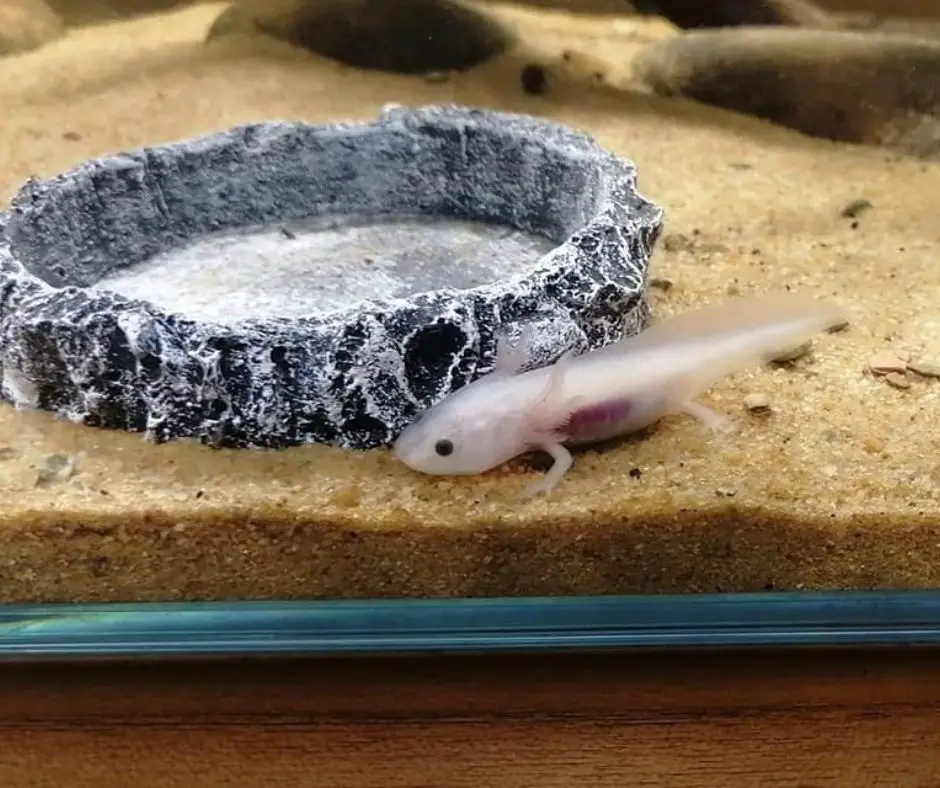
Exophthalmia
Exophthalmia, also called bulging eyes, is one of the health issues that can occur to baby axolotls.
A bulging eye in axolotl usually indicates that your axolotl is exposed to high nitrate levels for the long term.
A bulging eye may also indicate that your axolotl is morphing due to poor water conditions.
You can treat this by changing the water in your axolotl tank regularly. You can also invest in a filter to help keep the water quality level at an optimal level.
Hyperthermia
Generally, axolotls require cold water to stay healthy and active. Hyperthermia is a health condition where your axolotl becomes overheated due to high water temperatures.
Baby axolotls can experience hyperthermia if kept at a temperature above 73F or 23C.
Furthermore, hyperthermia can also lead to a decrease in oxygen concentrations in their tank and also cause bacterial infections.
Some of the symptoms that baby axolotl is suffering from hyperthermia are:
- Loss of appetite
- A build-up of fluid on your axolotl abdomen
- Your axolotl floats uncontrollably
You can treat hyperthermia by reducing the water temperature in their tank. You can refrigerate your axolotl to get quick relief.
However, you may need to do antibiotic therapy if your axolotl is infected by bacteria.
A great way to prevent this is to invest in a tank cooling system to help always keep your axolotl’s tank cool.
Also read: 5 Best Water Cooler For Axolotl
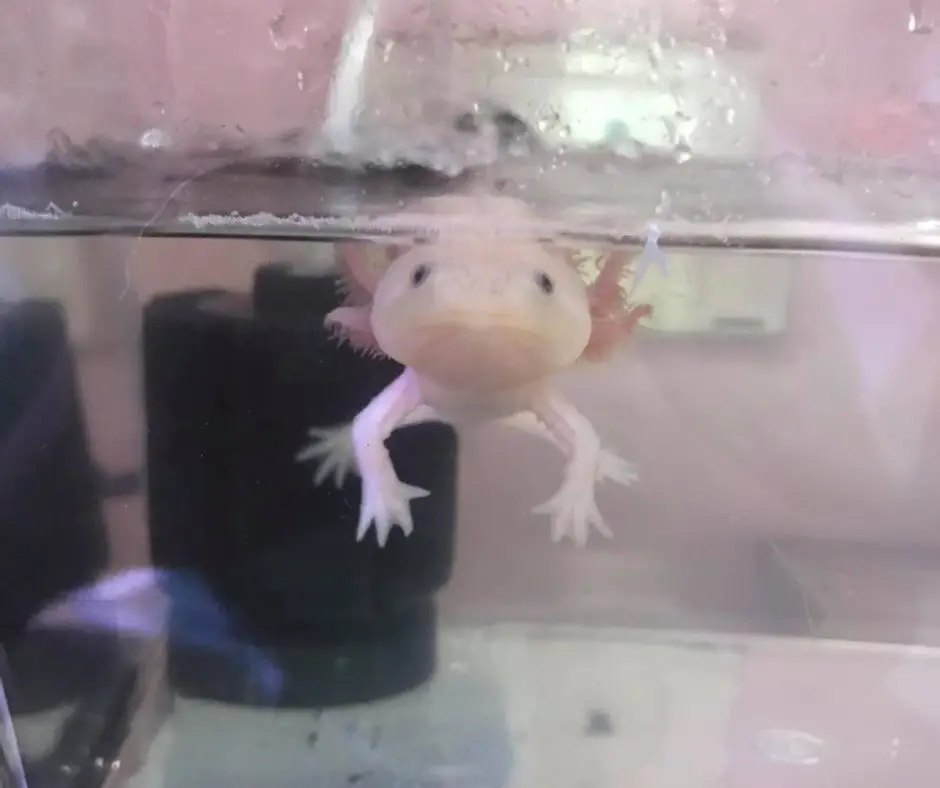
Overfeeding
Although axolotls can regulate their food intake, it is possible for the axolotl to become overfed.
Overfeeding in baby axolotl can cause health problems like impaction and obesity and are fatal in extreme cases.
This is because baby axolotls can suffer from digestive issues as they may not be able to digest their food.
Overfeeding can also make your baby axolotls reject foods. Rejected foods can then get trapped in the substrate and can easily affect the water quality in their tank.
This can then stress your axolotl, leading to health problems.
A great way to treat this is by feeding your axolotl with only the food they can consume in 1-3 minutes.
This will help ensure you feed them with the correct amount of food. When housing two or more axolotls, you also need to observe and ensure each fish is eating.
Also read: Axolotl Constipation: 8 Symptoms and 3 Ways Treatment
Underfeeding
Underfeeding is not usually as dangerous as overfeeding in axolotls. However, underfeeding can lead to stunted growth in baby axolotls and affect their growth rate.
Furthermore, underfeeding can expose baby axolotls to other health conditions in extreme cases.
You can treat underfeeding in baby axolotls by feeding your axolotls with adequate nutrients daily.
Also read: How Long Can Axolotls Go Without Food?
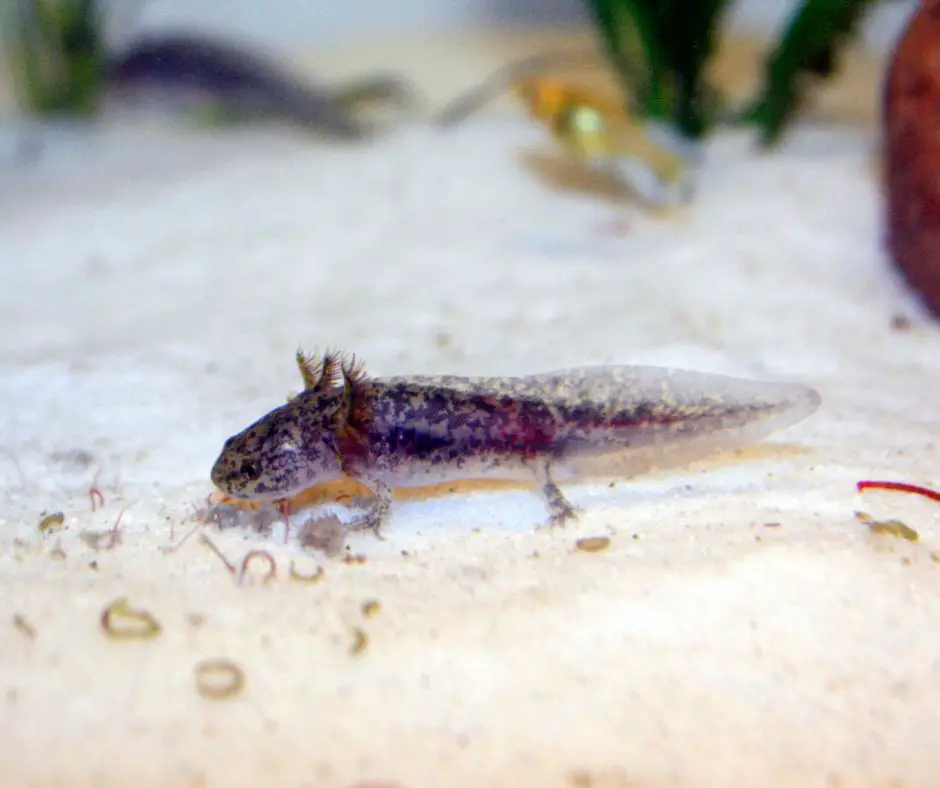
Skin Infections
The common skin infections affecting your baby’s axolotls are blisters and lesions.
Skin infection in baby axolotls is usually caused by bad water quality in their tank, and skin infection can also be caused by parasites.
You can treat skin infections by keeping your baby axolotl in a good water quality tank. However, you may need to consult the vet to diagnose and treat parasites that cause the issue.
A great way to prevent skin infection in baby axolotl is to check the water quality in your axolotl’s tank regularly.
Also read: 6 Common Axolotl Skin Conditions
Injuries
Your baby axolotls may have injuries such as missing a leg, losing their gills, a piece of their lip, and so on.
This usually occurs when you keep more than one axolotl together in the same tank. The axolotls can attack each other and even eat each other.
The reason for this is hunger, or you house them in a small enclosure. Axolotls can also get injured if there are decorations or shelters with sharp edges in their tank.
You can treat injuries in axolotls by isolating the axolotl in case its tank mate attacks it.
Furthermore, you should remove any decorations or shelters with sharp edges from the tank to prevent further injuries.
Also read: 6 Best Axolotl Accessories
Floating Upside Down
Another common health problem that can happen to baby axolotl is floating upside down.
This usually occurs because of their intestines’ gas accumulation, stress due to water quality, water temperature, poor digestion of food, and intestinal occlusion.
If your axolotl is floating upside down, the first thing to do is to scare it. Your axolotl will swim to the bottom if they have gas accumulation in their intestines.
However, you will need to quarantine your baby axolotl in a small tank to help stop this issue.
During this period, you can then check the tank’s water quality to help determine the cause of floatation.
However, if your axolotl is still floating after 4-5 days, you may need to consult with the vet as it may be suffering from intestinal occlusion.
Check out our article: Why Is My Axolotl Floating?
How Much Does A Baby Axolotl Cost?
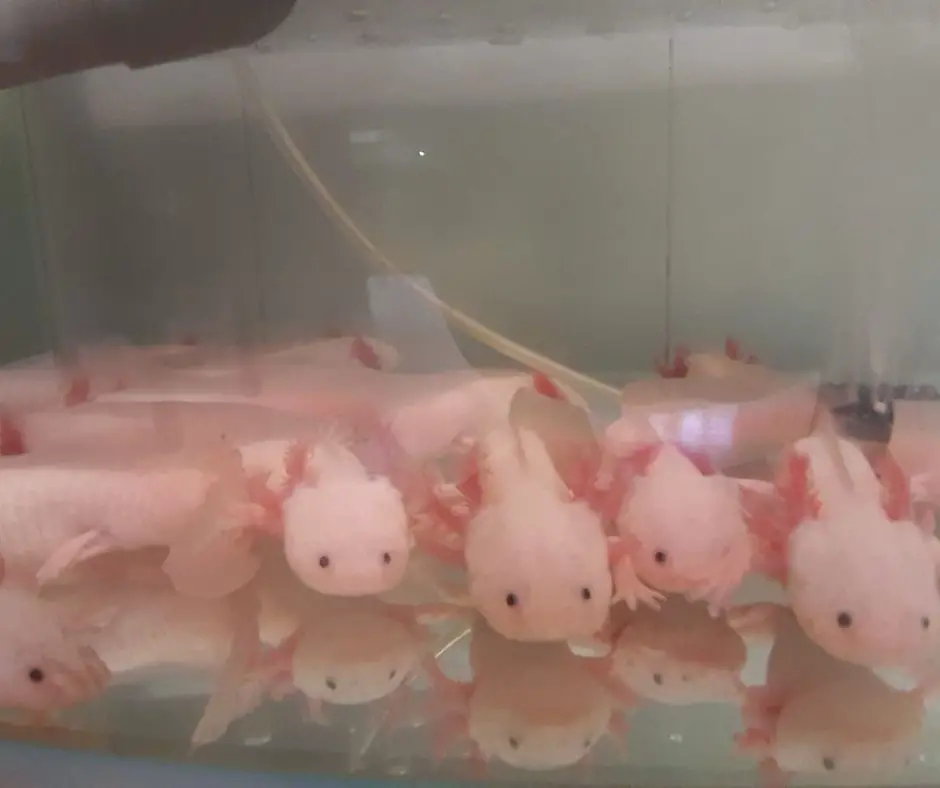
A common baby axolotl morph usually costs around $20. However, a rare baby axolotl morph can cost more.
Also read: How Much Does Axolotl Cost?
How to Select a Healthy Baby Axolotl
You should always be on the lookout for a healthy baby axolotl whenever you buy them. Some of the signs that indicate that a baby axolotl is healthy are:
- It is active
- The axolotl skin is smooth and not flaky
- It has a plump body
- Axolotl can lift their body and move around easily.
Some of the signs that indicate that an axolotl is sick are:
- It has a curled tail
- The axolotl is floating uncontrollably.
How Fast Do Baby Axolotls Grow?
A newly hatched axolotl is usually around 1cm long with no limbs. Baby axolotls grow at a fast rate, and with an ideal environment and food, they can grow one centimeter long in a week.
A baby axolotl can mature to a young adult about 12 inches long in about six months.
Aqueon 10 Gal Black Aquarium
- High quality glass construction with clean silicone sealed edges
- For freshwater and marine applications as well as desert or tropical terrarium applications
- Tank measures 20.25" long x 10.5" wide x 12.625" high
- Always include a drip loop when plugging aquarium appliances into the electrical outlet
- Place aquarium on a stand that is able to safely bear the weight of a filled aquarium
Last update on 2022-12-30 / Affiliate links / Images from Amazon Product Advertising API
Conclusion
Taking care of baby axolotls can be quite tasking for the inexperienced aquarist.
However, it can be a lot of fun caring for baby axolotls if you can take your time to provide the right tank, diet, and water parameters for your axolotl.
We hope that this article provides all the insights you need to make caring for baby axolotls very easy.
You can message us in the comment section below if you have any question or comment about caring for baby axolotls.
